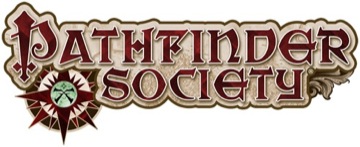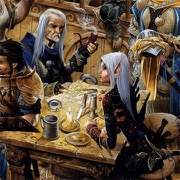Future of Pathfinder Society Update
Thursday, September 20, 2018
When we announced the Pathfinder Playtest in February, some of the first questions revolved around what Pathfinder Society would look like in the new edition. One of the questions the organized play team asked was what gave the Society its heart - made it the robust organized play system it is - and what could be improved. We've spent the last six months analyzing the past ten years of Society play, from how we organize scenarios to what role the Society has in the greater Pathfinder universe. We also asked our community feedback, posting several threads soliciting commentary on some of the key pieces of the Society. While we still have months of playtesting to go and aren't ready to make final decisions about what to include in our new Society, we did want to revisit the forum threads where we posed questions to the community, discuss the emerging trends, and refocus the discussion towards the most likely options.
Eight threads are too much for any one person to monitor, especially when they span pages and pages of commentary. To make the task easier, each of the organized play team members focused on two threads. Over the next few months, we will dedicate at least one blog every month on our discussion. This week, we are going to focus on the Tier discussion and how it impacts level gain, which was one of Linda's foci, and the revised Roleplaying Guild Guide, which is an area I've monitoring.
At the end of this blog is a link to a SurveyMonkey form with a few questions regarding the discussion topics of tiers, experience points, and the Roleplaying Guild guide. Please read through the blog, then take the survey. Just to note, we are only talking Pathfinder Society version 2 in this survey. Depending on how things work out, what we decide for version 2 may make its way into Starfinder Society, but that is a topic for another day.
From Linda-Zayas Palmer, Organized Play Developer:
Tiers
One of the primary topics of this thread is the appropriate size for tiers in scenarios. The community discussion centered around three primary models for the size of typical tiers.
- Tiers that are three levels wide with no sub tiers (Level 1, 3, 5, etc. scenarios that are playable by characters within one level of the adventure's stated level - level 5 adventures are playable by level 4-6 characters.)
- Tiers that are four levels wide with two sub tiers, as in Starfinder Society (Tier 1-4, 3-6, 5-8, etc.)
- Tiers that are five levels wide with two sub tiers, as in the current version of Pathfinder Society (Tier 1-5, 3-7, 5-9, etc.).
There were also some interesting points in the thread about the possibilities for non-standard tier sizes to accommodate particularly low or high-level play. We are likely to continue to offer adventures with narrow tier bands for low-level characters (Such as Tier 1 or 1-2 scenarios). When it comes to possibilities for higher level play, that is a bridge we'll be looking to cross in the future, when there are PCs available to play adventures of those levels, and when we've all had a chance to become familiar with how high-level play works in Pathfinder Second Edition.
The tier discussion also included a fair amount of discussion about APL (Average Party Level) and how to use it to determine which adjustments to apply to the adventure based upon the strength of the party. This conversation included ideas for how best to calculate APL, and how best to make adjustments that serve both large groups of lower level PCs and small groups of higher-level PCs. Because the specifics of how we handle adjustments will have to depend upon the size of the tiers, we aren't ready to offer complete proposals on this topic yet. However, as you may have noticed if you GMed one of the Pathfinder Society Playtest scenarios, we are strongly considering writing scenarios for a baseline of four players, with step adjustments provided for 5 and 6 (possibly even 7) players, versus the Pathfinder Society model of writing for tables of six players with a four-player adjustment.
We are considering several models for XP gain, based on the suggestions we have received. Regardless of the model, longer adventures like Adventure Paths would give more XP than a standard scenario, and quests would give less. Which brings up a discussion on the role of quests. The current default model for quests is to release 1-2 "packs" of quests per year, which each contain 4 or 5 adventures that together tell a cohesive story. We've received a lot of feedback, both on the forums and in person, that this model creates scheduling challenges. What we currently investigating is a model based around self-contained quests that release on a regular schedule, such as 1 quest per month. This would allow for more flexibility in scheduling, as the storyline won't be cohesive across individual quests, as well as maintain a constant flow of short events to be run at conventions, game stores, and other venues throughout the year.
With the above quest revisions in mind, which of the models below do you prefer?
The level gain portion of the thread also included some suggestions to create an XP system in which characters leveled up more quickly at low levels and more slowly at high levels. While these are interesting ideas and they may work best for some folks, the prevailing preference toward simplicity in the way we handle XP makes us unlikely to follow up on them. Instead, we would recommend that players looking to level up more slowly at higher levels use a voluntary system like slow track.
Speaking of slow track, we'd like to hear your thoughts on that as well. In Pathfinder Society, there is a leveling option called slow track, where players can choose to receive less XP, gold, and Fame for playing adventures', causing them to level more slowly.
The Roleplaying Guild Guide
The discussion on tiers, levels, and experience took a goodly amount of space, so I'm going to keep the guide conversation brief. Many of the comments about the current guide involved its size, organization, and accessibility. To that end, we are looking at stripping the guide back to its bare bones and put it together from the ground up. I've included survey questions about what should be in the guide and how it should be organized.
Part of this discussion revolves around delivery options. The big question at this point revolves around the feasibility of supporting a living document that resides online with print options. This would allow for faster updates and more integration between the guide, campaign clarifications, additional resources, and FAQ. Conversely, it means the guide is always in flux and could cause issues if internet access is not robust.
With the above thread discussions in mind, please take a moment to visit Org Play Survey #1—Tiers, XP, and Guides and log your opinions on the above talking points via a short survey. Conversely, you can add freeform comments below or in the applicable threads (Tiers & Level Gain, Roleplaying Guild Guide). Regardless of how you share your opinions, please do so, as we want to hear your thoughts on the directions of the future Pathfinder Society!
PAX Unplugged
We have a room for Pathfinder & Starfinder Societies and a booth hosting demonstration of the Pathfinder Playtest going on at PAX Unplugged 2018! Information on volunteer packages and a registration form will be available here on Friday, September 21st, 2018 at noon PST.
If you didn't read the blogs yesterday, flip back for previews of scenarios releasing in September for the Pathfinder and Starfinder Societies, including the last of the Pathfinder Playtest scenarios! If you are caught up, tune in next week for a status update on the Pathfinder Playtest society style or check out some of the other Paizo-centric blogs!
Until next time—Explore, Report, Cooperate!
Tonya Woldridge
Organized Play Manager
We have updated our Privacy Policy.
Paizo.com uses cookies. You can block paizo.com from using cookies within your browser settings, but doing so will hinder site functionality.
More information can be found in our Privacy Policy.

